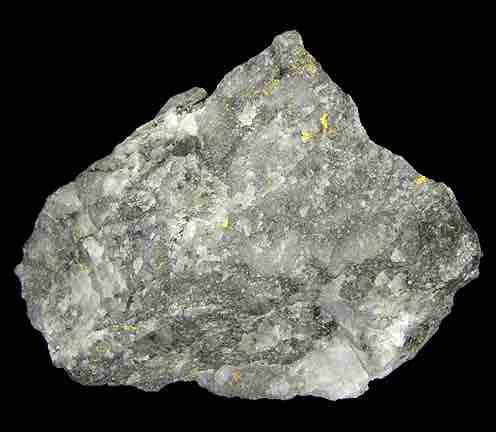Ores
An ore is a type of rock that contains minerals with important elements such as metals. Ores are extracted through mining; they are then refined to extract the valuable element(s). The grade or concentration of an ore mineral, or metal, as well as its form of occurrence, will directly affect the costs associated with mining it. The cost of extraction must be weighed against the metal value contained in the rock to determine which ores should be processed and which ores are of too low a grade to be worth mining.

Gold Ore
High-grade gold ore from a quartz vein near Alma, Colorado. The appearance is typical of very good gold-quartz ore.
Metal ores are generally oxides, sulfides and silicates of "native" metals (such as native copper) that are not commonly concentrated in the Earth's crust. Ore bodies are formed by a variety of geological processes. The process of ore formation is called ore genesis.
Ore Preparation
It takes multiple steps to extract the "important" element from the ore:
- First, the ore must be separated from unwanted rocks.
- Then, the minerals need to be separated out of the ore
- Since most minerals are not pure metals, further separation methods are required.
Most minerals are chemical compounds that contain metals and other elements.
Extractive Metallurgy
Extractive metallurgy is the practice of removing valuable metals from an ore and refining the extracted raw metals into a purer form. In order to convert a metal oxide or sulfide to a purer metal, the ore must be reduced physically, chemically, or electrolytically. Extractive metallurgists are interested in three primary streams: feed, concentrate (valuable metal oxide/sulfide), and tailings (waste).
After mining, large pieces of the ore feed are broken through crushing and/or grinding. This step creates particles that are either mostly valuable or mostly waste. Concentrating the particles of value in a form supporting separation enables the desired metal to be removed from waste products.
Ore bodies often contain more than one valuable metal. Tailings of a previous process may be used as a feed in another process to extract a secondary product from the original ore. Additionally, a concentrate may contain more than one valuable metal. That concentrate would be processed to separate the valuable metals into individual constituents.
Hydrometallurgy
Hydrometallurgy is concerned with processes that use aqueous solutions to extract metals from ores. The most common hydrometallurgical process is leaching, which involves dissolution of the valuable metals into the aqueous solution. After the solution is separated from the ore solids, the solution is often subjected to various processes of purification and concentration before the valuable metal is recovered, either in its metallic state or as a chemical compound. The solution purification and concentration processes may include precipitation, distillation, adsorption, and solvent extraction. The final recovery step may involve precipitation, cementation, or an electrometallurgical process.
Sometimes, hydrometallurgical processes may be carried out directly on the ore material without any pretreatment steps. More often, the ore must be pretreated by various mineral processing steps and sometimes by pyrometallurgical processes.
Pyrometallurgy
Pyrometallurgy involves high temperature processes where chemical reactions take place among gases, solids, and molten materials. Solids containing valuable metals are either reacted to form intermediate compounds for further processing, or they are converted into their elemental or metallic state. Pyrometallurgical processes that involve gases and solids are typified by roasting operations. Processes that produce molten products are collectively referred to as smelting operations. The energy required to sustain the high temperature pyrometallurgical processes may come entirely from the exothermic nature of the chemical reactions taking place, usually oxidation reactions. Often, however, energy must be added to the process by combustion of fuel or, in the case of some smelting processes, by the direct application of electrical energy.
Electrometallurgy
Electrometallurgy involves metallurgical processes that take place in some form of electrolytic cell. The most common types of electrometallurgical processes are electrowinning and electro-refining. Electrowinning is an electrolysis process used to recover metals in aqueous solution, usually as the result of an ore having undergone one or more hydrometallurgical processes. The metal of interest is plated onto a cathode, while an anode is composed of an inert electrical conductor. Electro-refining is used to dissolve an impure metallic anode (typically from a smelting process) and produce a high purity cathode. Fused salt electrolysis is another electrometallurgical process whereby the valuable metal is dissolved into a molten salt, which acts as the electrolyte, and the valuable metal collects on the cathode of the cell.
The scope of electrometallurgy has significant overlap with the areas of hydrometallurgy and (in the case of fused salt electrolysis) pyrometallurgy. Additionally, electrochemical phenomena play a considerable role in many mineral processing and hydrometallurgical processes.